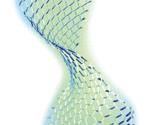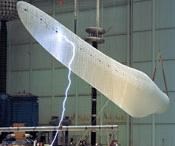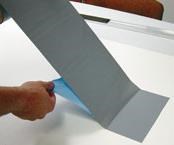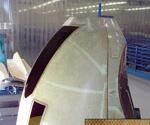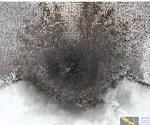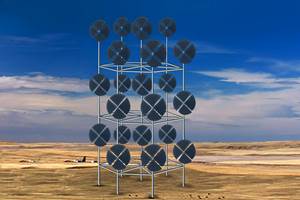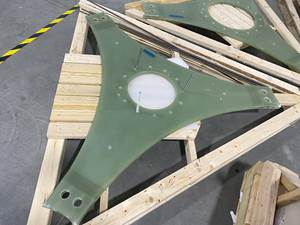Lightning Strike Protection For Composite Structures
Composite structures are more vulnerable to damage than metal, but today's LSP products offer proven protection.
General aviation aircraft, large commercial jets and wind turbines are vulnerable to lightning strike. FAA-certified aircraft, for example, are typically struck once or twice a year. Unlike their metal counterparts, composite structures in these applications do not readily conduct away the extreme electrical currents and electromagnetic forces generated by lightning strikes. Composite materials are either not conductive at all (e.g., fiberglass) or are significantly less conductive than metals (e.g., carbon fiber), so current from a lightning strike seeks the metal paths available. For that reason, lightning strike protection (LSP) has been a significant concern since the first composites were used on aircraft more than 30 years ago.
If a lightning bolt strikes an unprotected structure, up to 200,000 amps of electricity seeks the path of least resistance. In the process, it may vaporize metal control cables, weld hinges on control surfaces and explode fuel vapors within fuel tanks if current arcs through gaps around fasteners. These direct effects also typically include vaporization of resin in the immediate strike area, with possible burn-through of the laminate. Indirect effects occur when magnetic fields and electrical potential differences in the structure induce transient voltages, which can damage and even destroy onboard electronics that have not been EMF (electromagnetic field) shielded or lightning protected. The need for protection of composite structures has prompted development of a number of specialized LSP materials.
Protection basics
LSP strategies have three goals: provide adequate conductive paths so that lightning current remains on the structure's exterior; eliminate gaps in this conductive path to prevent arcing at attachment points and ignition of fuel vapors; and protect wiring, cables and sensitive equipment from damaging surges or transients through careful grounding, EMF shielding and application of surge suppression devices where necessary.
Traditionally, conductive paths in composite structures have been established in one of the following ways: (1) bonding aluminum foil to the structure as the outside ply; (2) bonding aluminum or copper mesh to the structure either as the outside ply or embedded one ply down; or (3) incorporating strands of conductive material into the laminate. All require connecting the conductive pathways to the rest of the aircraft in order to give the current an ample number of routes to safely exit the aircraft. This is typically achieved by using metal bonding strips (i.e., electrical bonding) to connect the conductive surface layer to an internal "ground plane," which includes metal components such as engines, conduit, etc. Because lightning strikes can attach to metal fasteners in composite structures, it may be desirable to prevent arcing or sparking between them by encapsulating fastener nuts or sleeves with plastic caps or polysulfide coatings.
For external surface protection, a number of metal and metallized fiber products have been developed, typically woven and nonwoven screens and expanded foils. These mesh-like products enable the lightning's current to quickly transmit across the structure's surface, reducing its focus. According to Ed Rupke, senior engineer for Lightning Technologies Inc. (LTI, Pittsfield, Mass.), aluminum wire was one of the first LSP materials, interwoven with carbon fiber as part of the laminate. However, using aluminum with carbon fiber risked galvanic corrosion (the result when two dissimilar metals act similarly to a battery, causing the metal that acts as the anode to corrode). Copper wires relieve the threat of galvanic corrosion but are three times as heavy as aluminum. As fiberglass composites gained usage in aircraft, the industry investigated foils and then expanded foils, which can be cocured with the laminate's exterior ply. Coated fibers (nickel or copper electrodeposited onto carbon and other fibers) also are used but perform much better in EMF shielding applications than as direct lightning strike protection.
Metal mesh and expanded foil
Astrostrike aluminum mesh is produced by Astroseal Products (Chester, Conn.) from a solid foil, which is then perforated and expanded to increase formability and augment adhesion to composite structures. Astroseal claims that its product provides significantly greater conductivity than woven mesh, while offering weight savings vs. metallized fiber products (see "Metallized fabrics and fibers," p. 47). Cirrus (Duluth, Minn.) uses Astrostrike on the fiberglass composite airframes of its FAA-certified SR-20 and SR-22 single-engine, piston-powered aircraft. Astrostrike aluminum mesh is embedded in the composite layup, and 3-inch to 4-inch (76 mm to 102 mm) metal strips run the length of the plane to electrically bond the aircraft's surfaces to its frame. The company knows of two lightning strikes to Cirrus aircraft: one hit the propeller tip and went through the engine; the other went through the airframe and exited through metal flake paint on the plane's graphics. Both were conducted through the aircraft as designed, without causing injuries or seriously damaging structures or equipment. The pilots were able to fly home without problems. Paul Brey, director of airframe engineering, says Cirrus is evaluating a thinner, lighter weight Astrostrike product as a manufacturing upgrade to improve surface finish and reduce manufacturing costs.
Adam Aircraft (Englewood, Colo.) manufactures the FAA-certified twin-prop (inline push/pull) pressurized A500 aircraft and is completing FAA certification for its A700 jet. Both have carbon-fiber composite airframes and use Astrostrike nonwoven copper mesh, which eliminates the risk of galvanic corrosion with carbon composites and is only a few mils thick. "We use it on almost the entire aircraft," explains Kerry Manning, structures lead engineer. "It adds very little thickness because it is layed up as the first ply, with the rest of the laminate built on top of it."
Adam Aircraft employed LTI both as an LSP consultant during development and as its lightning strike testing firm during the six-month FAA certification process for the A500's LSP system. Adam Aircraft knows of one strike, so far, to its A500 aircraft, which resulted in insignificant damage to the airframe. According to Manning, "Using LTI early on saved a lot of time and helped us to avoid many pitfalls."
Manning notes, however, that finishing steps must be carefully performed. "We prime and paint as usual, but we have learned that the paint thickness must be controlled," he explains. "If the paint is too thick, the lightning does not readily conduct through to the copper mesh and we end up with damage." The A500 and A700 also use metal bonding straps between wings and fuselage to establish a ground plane for tying in the airframe and avionics.
A number of suppliers provide expanded foils, which do not require a more costly weaving process to produce and reportedly offer greater drapability and conformability than wovens. Dexmet (Naugatuck, Conn.) supplies a large variety of conductive metal products for aircraft, including aluminum, copper, phosphorous bronze, titanium and other materials. Dexmet is prepared to modify any design to meet precise customer needs and works with customers to test and evaluate custom and standard LSP designs. Dexmet claims to be the only company worldwide to supply expanded 0.004 inch/0.1 mm aluminum in 48 inch/1,219 mm widths, which can reduce labor cost during application.
Strikegrid is a phosphoric acid-anodized continuous expanded aluminum foil (CEAF) product supplied by Alcore (Edgewood, Md.), part of the M.C. Gill Corp. group of companies. It claims superior corrosion resistance and environmental longevity due to a proprietary coating. It is supplied on continuous rolls in 24 inch to 36 inch (610 mm to 914 mm) widths and in 2-mil and 4-mil thicknesses.
In Europe, aluminum LSP mesh is supplied by ECC GmbH & Co. KG (formerly C. Cramer & Co., Heek-Nienborg, Germany). Diamond Aircraft (London, Ontario, Canada) uses the mesh on its composite-airframed DA 40 aircraft, which was developed in Austria and certified by the Austrian equivalent of the FAA. Don Uffen, engineering manager for the company's piston engine programs in Canada, describes the lightning strike protection system for the DA 40, "Aluminum mesh is used on the strike zones of the fiberglass aircraft structure and also on the carbon composite wing skin near the wing tips." The LSP fabric used is ECC's 3K carbon, 2x2 twill fabric with aluminum threads (Style 459). The epoxy resin reportedly helps to prevent galvanic corrosion between the aluminum mesh and carbon fiber composites. The aircraft's lightning protection was tested by Culham Lightning Ltd. (Abingdon, Oxfordshire, U.K.). "All surfaces and structures are electrically bonded via a redundant path of aluminum tubular conduits — used to run wiring harnesses through the aircraft — and interconnected flat aluminum straps," says Uffen. "The tubing and straps have been sized to make sure they can carry the required lightning current to prevent damage." Lightning protection for the DA 42 is essentially the same, even though it uses more carbon composites than the DA 40.
Ply-integrated LSP
Among the newest developments — so new, they were unavailable for consideration on many recent aircraft programs — are "all-in-one" LSP prepregs, which contain pre-embedded woven or nonwoven metal meshes. Applied first-down in layups, the products significantly reduce kitting and manufacturing costs, according to their suppliers.
Strike Guard LSP prepreg is manufactured by APCM (Plainfield, Conn.), and sold through and supported by partner/distributor Advanced Materials and Equipment (Barkhamsted, Conn.). APCM's LSP prepregs are made from either woven or nonwoven metal mesh impregnated with hot-melt adhesive resins that are modified with additives to enhance conductivity of the matrix, making the entire prepreg a conductive system. Metal mesh options include copper, aluminum, phosphor bronze and nickel/copper-coated polyester fiber in various sizes, ranging in weight from 0.08 lb/ft2 to 0.060 lb/ft2. Prepregs also are available with a lightweight nonwoven fiberglass veil that enhances surface finish, reducing porosity and secondary finishing required prior to painting.
Using a combined prepreg/veil system like Strike Guard ensures that the mesh is completely wet out by the resin, lessening the risk of air entrapment as compared to a separate layup of a resin film and dry mesh. For handling ease, Strike Guard prepregs come with a paper release on one side and poly release on the other. A 1-inch/25.4-mm, no-veil edge can be specified so that conductivity can be achieved by overlapping adjacent plies. Strike Guard is used by several general aviation manufacturers worldwide.
Henkel Corp.'s (Bay Point, Calif.) LSP surfacing film combines its SynSkin composite surfacing film and Hysol film adhesives with Astroseal's lightweight conductive Astrostrike screens to provide a family of lightning strike surfacing layers. They reportedly ease handling and layup, and improve the surface quality of the cured part. The screens also can reduce the cost of surface preparation for painting, lower raw material part numbers and kitting time, and can be cocured with prepregs. SynSkin's unique combination of filler materials and resin matrix reportedly makes it nearly impossible to sand through once cured, offering dramatically better protection of the conductive screen during sand-and-fill operations than all-epoxy film adhesives.
Cytec Engineered Materials (Tempe, Ariz.) also produces LSP products in the form of film adhesives and surfacing films that incorporate perforated foils. FM-300 and FM-1515-3 are structural film adhesives that were developed for customers who want to have only one material qualified for both structural and LSP uses. SURFACE MASTER 905 composite surfacing film is billed by Cytec as its next-generation LSP product. According to Dr. Dalip Kohli, product development manager, "SURFACE MASTER 905 has been designed specifically to produce a composite structure with no pinholes or surface defects of any kind." He continues, "Porosity is a problem that only gets worse when adding lightning strike materials such as metal mesh. SURFACE MASTER 905 is available with expanded copper screen (ECS) or expanded aluminum screen (EAS) already embedded in, so that a defect-free surface with lightning strike protection is easy to achieve." Reportedly pliable and drapable like a film adhesive, SURFACE MASTER 905 contains enough resin in the film to permit surface sanding without damaging the embedded metal screen. According to Cytec, the product passed a full battery of lightning strike tests performed by Lightning Technologies Inc., including those for aircraft zones 1A and 1B, and has been qualified by major OEMs, including Boeing, Airbus, Bell, Bombardier and Embraer. The product is supplied on rolls, 36 inches to 54 inches wide (91.4 cm by 137 cm) and is approximately 5 mils thick.
Hexcel (Stamford, Conn.) says its variety of LSP combinations reduce weight and manufacturing costs vs. more traditional materials, and are being used in aircraft and wind turbines. Hexcel can supply its HexWeb CR-PAA (phosphoric acid-anodized) aluminum expanded foil as a standalone product or combined with its prepregs and/or adhesives into a multilayered LSP system. Additionally, the company's Redux adhesives and HexPly resins can be paired with bronze, copper, aluminum mesh or expanded foils. A more unusual option is the company's Interwoven Wire Fabrics, which feature small diameter wires that are woven into carbon cloth fabric to create a single-layer LSP system. Wire options for this system include phosphor bronze, aluminum and others, which can be incorporated into in a variety of weave styles with a range of wire concentrations, which then can be prepregged with Hexcel resins. If isolation of a carbon composite layer is needed, Hexcel can incorporate fiberglass fabrics into any of the multilayered products that includes metal foil or mesh.
Metallized fabrics and fibers
Several companies supply metallized fabrics and/or metallized fibers that may be used to produce LSP fabrics. Diamond Fiber Composites (Cincinnati, Ohio) coats carbon fibers with a wide variety of metals including nickel, copper, silver, gold, palladium, platinum and metal hybrids (multilayer coatings) using what the company calls an "electroless" plating process, a completely chemically based coating process that reportedly provides a more uniform coating than electroplating processes do. These coated fibers may be obtained as continuous fiber lengths, chopped fibers, woven fabrics and nonwoven veils/mats.
Electro Fiber Technologies (Stratford, Conn.) offers single or dual metal hybrids coated onto carbon, graphite, glass, polyester and other synthetic fibers. The company supplies chopped fibers (down to 1 mm/0.04 inch in length) and continuous tows from 3K to 80K as well as nonwoven veils and mats.
Technical Fibre Products (Newburgh, N.Y.) supplies electrically conductive nonwoven mats and veils using carbon, nickel-coated carbon, aluminized glass, silicon carbide, stainless steel and nickel fibers. The company also can custom-blend fibers, particulates and binders using a unique wet-laying technology.
Textile Products Inc. (Anaheim, Calif.) supplies a Style #4607 216 g/m2 carbon/aluminum hybrid fabric made with AS4-3K carbon fiber and aluminum wire. It also supplies a Style #4608 218 g/m2 hybrid with T650/35-3K carbon fiber and aluminum wire. Both are plain weaves, 14 mils thick and 107 cm/42 inches wide.
Varinit (Greenville, S.C.) supplies electrically conductive reinforcing fabrics, developing and manufacturing products to meet customer specifications.
As an alternative to aluminum and copper LSP products (such as the copper mesh used by by Adam Aircraft, noted above and Epic Aircraft, noted below), the AFN Advanced Fiber Nonwovens Group (Hawkinsville, Ga.) of Hollingsworth & Vose Co. (East Walpole, Mass.) has developed a new nickel-coated carbon fiber nonwoven material. This new LSP veil has been tested by Lightning Technologies Inc. (LTI) and has passed the most severe Zone 1A lightning strike tests (see "Protection Requirements," p. 47). Detailed in a recent SAMPE 2006 presentation, the nickel-coated carbon veil performed well vs. aluminum metal mesh, with no damage to any fibers below the LSP due to the veil's ability to distribute energy across the entire surface of the panel. This flexible, lightweight and highly conductive LSP veil reportedly is easier to handle and repair than aluminum mesh products and does not require an isolation layer to prevent galvanic corrosion, simplifying fabrication and providing weight and cost advantages.
Tying LSP into the aircraft system
LSP products provide sufficient protection only when adequately incorporated into an aircraft's overall protective system — a job that sometimes tests ingenuity on the part of the aircraft manufacturer. For example, Epic LT and Epic Jet, both with carbon composite-airframes and built by Epic Aircraft (Bend, Ore.), feature a standard copper mesh but incorporate an inventive element. When the composite wings, fuselage skins and horizontal stabilizers are layed up, a copper tang (a thin or pointed projection that serves as an attachment point) is placed as a conductive hard point within the laminate, contacting not only the embedded copper mesh but also the bonding straps that bridge the gap between fuselage and wing. Epic Aircraft uses a film to reduce surface porosity caused by the copper mesh. Another innovative feature is Epic's use of conductive adhesive to tie static wicks into the aircraft's grounded surface grid. This bonding adhesive is modified to conduct current, and although it is not designed for lightning strikes, it works well in providing a link to disperse static charge.
For its composites-intensive midsize 787 commercial passenger jet, The Boeing Co. (Seattle, Wash.) has developed a multilayered approach to its lightning strike protection strategy. Boeing plans to use a thin metal mesh or foil in the outer layers of the composite fuselage and wings to quickly dissipate and route charge overboard and shield onboard electronics. To avoid slight gaps between wing-skin fasteners and their holes, which could enable sparking, Boeing will install each fastener precisely and then seal it on the inside. Boeing will use nonconductive goop or glass fiber to seal edges where wing skins meet internal spars in order to prevent gaps, which could permit electrons to spray out during a lightning strike, a phenomenon referred to as "edge glow." In the fuel tanks, Boeing will eliminate the threat of exploding fuel vapors by installing a nitrogen-generating system (NGS) that minimizes flammable vapors in wing tanks by filling the space with inert nitrogen gas.
Add-on LSP
Integument Technologies (Tonawanda, N.Y.) has developed a variety of polymer-based, peel-and-stick appliqués, which can be installed on composite surfaces after construction. One of the few products available for achieving LSP retrofit to existing structures, the appliqués reportedly are lighter than traditional embedded mesh products and reduce the cost and difficulty of repair. Since they are placed over the composite surface, damage tends to be confined to the appliqué, and repairs typically can be done without having to cut out the affected area: The portion of appliqué that is affected is simply removed and replaced with a new appliqué section. These appliqués must be replaced if struck by lightning, but this is common for LSP, because the resin for embedded products typically vaporizes, necessitating repair.
Available in 6-inch/152 mm tapes and films up to 36 inches/914 mm in width, these products also can be custom-sized to meet specific application requirements and are typically 3 mils in thickness. Their cost ranges from $17/ft2 to $50/ft2. Current applications include not only aircraft but wind turbine blades as well.
Lightning Diversion Systems (Huntington Beach, Calif.) has developed a thin "conformal shield" product for composite exterior surfaces. Offering protection from direct or indirect lightning effects, the shield is lightweight and produces a smooth finish. Vought Aircraft and Kaman Aerospace are using the product, which is more expensive than machined metal scrims but also can be stretched, providing enhanced conformability to complex curvatures. The conformal shield is supplied in 24-inch by 26-inch (610 mm by 660 mm) panels and in thicknesses as low as 1 mil, in aluminum or copper and nickel-plated versions that eliminate the risk for galvanic corrosion when used with carbon/epoxy laminates. The firm also produces segmented lightning diverter strips for radomes, which consist of very small diameter (0.01 inch/0.25 mm) metal discs aligned on thin (0.005 inch to 0.010 inch or 03 mm to 0.25 mm) laminate strips. The spacing between the discs allows the air above to ionize, safely guiding lightning in a channel above the diverter strip. They offer permanent, multistrike protection vs. foil products, which evaporate upon lightning impact, plus lighter weight and lower aerodynamic drag than solid metal bars, and lower maintenance than the complex fastener design of internal rod systems, with negligible effect on the radio frequency (RF) patterns of enclosed radar antennas.
LSP for wind blades
Though ground-based, wind turbines are a natural lightning strike target, due to their height. The blades are one of the most expensive components of a wind turbine, and the longer the blade, the greater its risk of being struck by lightning along its surface as well as at its edge or tip. Effects can include surface damage, delamination, cracks in leading and trailing edges, and hidden damage that may lead to serious long-term problems and reduced service life. When struck by lightning, an unprotected wind blade experiences an electric arc from the point of contact, through conductive components, to the root, reaching temperatures of up to 30,000°C (about 54,000°F) and possibly exploding the blade. Wind turbines continue to increase in size, and those placed offshore are even more exposed to lightning strikes than those on land.
While the above-mentioned LSP products are effective for use on wind blades, LM Glasfiber (Lunderskov, Denmark) has developed instead its LM LightningProtection, a unique solution for blade protection. The goal was a simple, robust system with the same service life as the rest of the blade. It consists of receptors on the surface of the blade, which intercept the lightning, and a conductive cable system within the blade that carries charge to the grounded tower. The receptors are made from a special tungsten alloy with excellent conductive qualities and resistance to intense heat. The surface of the receptor will partly evaporate with repeated lightning strikes, but the receptor can withstand several strikes before it needs to be replaced, which is easy due to the receptor's simple construction.
Protecting carbon composite blades presents a unique challenge, because the semiconductive laminate is struck by lightning as frequently as the receptors. Embedding a metal mesh in the laminate was undesirable because lightning strikes that contact the mesh produce damage that must be inspected and repaired. "It's too expensive to repair or replace blades on offshore wind farms," states Jesper M^nsson, head of technical advisory services at LM Glasfiber. The company adapted the idea of diverter strips used in aircraft radomes. The resulting segmented diverters use many small, closely spaced air gaps that ionize in the presence of lightning to guide the current, rather than conduct it, across the protected surface. This system required careful design because combining metal conductors and carbon composites can create electrical voltage potentials, as a result of the materials' differing conductivities. During a strike, a spark can occur between these conductive parts, resulting in damaging carbonization over time and unwanted new electrically conductive paths.
To minimize blade service/maintenance once wind turbine blades are in operation, LM Glasfiber developed its LM BladeMonitoring system, which records not only each incidence of lightning strike, but its maximum current, rise time and specific energy as well. The system enables wind farm operators to have data sent directly to a computer via a wireless connection, which then can be used to assess blade condition and determine if the turbine was damaged. An LM BladeMonitoring prototype has been in operation for two years, while almost 70,000 blades have been equipped with LM LightningProtection.
Repair of protected surfaces
After a lightning strike, repairs must be done properly to regain the conductive path. A technical paper presented at the SAMPE 2006 Symposium (Long Beach, Calif.) by Lou Dorworth, senior instructor for Abaris Training (Reno, Nev.), concluded that current methods of repairing LSP for composite structures with metal mesh and film adhesive often result in surface porosity that later permits moisture ingress. After conducting a series of repair experiments, Dorworth found that using a mesh-embedded surfacing film reduced or eliminated surface porosity on carbon composite sandwich structure. He also found that the optimum surface was obtained by using separate layers of mesh and surfacing film, applied so that the film overlaps the mesh and provides an adequate fillet around the repair edges. Compared to current methods, this approach replaces the outermost layer of film adhesive with surfacing film in order to bond and seal the mesh-to-mesh interface (repair patch mesh must be bonded and sealed to original surface mesh in order to restore the conductive path).
Related Content
Novel composite technology replaces welded joints in tubular structures
The Tree Composites TC-joint replaces traditional welding in jacket foundations for offshore wind turbine generator applications, advancing the world’s quest for fast, sustainable energy deployment.
Read MoreDrag-based wind turbine design for higher energy capture
Claiming significantly higher power generation capacity than traditional blades, Xenecore aims to scale up its current monocoque, fan-shaped wind blades, made via compression molded carbon fiber/epoxy with I-beam ribs and microsphere structural foam.
Read MoreComposites end markets: Energy (2024)
Composites are used widely in oil/gas, wind and other renewable energy applications. Despite market challenges, growth potential and innovation for composites continue.
Read MoreRTM, dry braided fabric enable faster, cost-effective manufacture for hydrokinetic turbine components
Switching from prepreg to RTM led to significant time and cost savings for the manufacture of fiberglass struts and complex carbon fiber composite foils that power ORPC’s RivGen systems.
Read MoreRead Next
VIDEO: High-volume processing for fiberglass components
Cannon Ergos, a company specializing in high-ton presses and equipment for composites fabrication and plastics processing, displayed automotive and industrial components at CAMX 2024.
Read MorePlant tour: Daher Shap’in TechCenter and composites production plant, Saint-Aignan-de-Grandlieu, France
Co-located R&D and production advance OOA thermosets, thermoplastics, welding, recycling and digital technologies for faster processing and certification of lighter, more sustainable composites.
Read More“Structured air” TPS safeguards composite structures
Powered by an 85% air/15% pure polyimide aerogel, Blueshift’s novel material system protects structures during transient thermal events from -200°C to beyond 2400°C for rockets, battery boxes and more.
Read More




